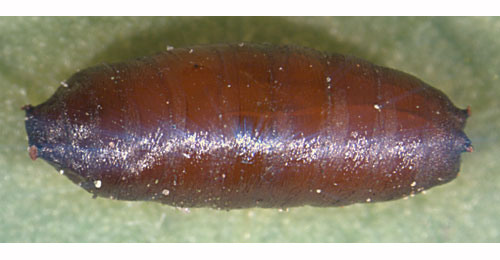|
||||||
|
OXYRIA. Mountain sorrel. [Polygonaceae] |
|
Mountain Sorrel (O. digyna) is the only species of Oxyria recorded in Britain. It is a native species. Three British miners are recorded on Oxyria. A key to the European miners recorded on Oxyria is provided in Bladmineerders van Europa. |
|
Key for the identification of the known mines of British |
1a > Leaf-miner: Large upper side blotch or blister mine, which can start with a short corridor. In small leaves the mine can be full depth in places. Often several larvae in a mine; frass irregularly scattered in large lumps. Pupation external. |
|
Pegomya bicolor (Wiedemann, 1817) [Diptera: Anthomyiidae]. |
1b > Leaf-miner: Linear mine, becoming a blotch. Two or more larvae feeding together. Frass in lines. At the start of the mine on the leaf under surface a group of about 5 oval white egg shells (just 1 on the small leaves of Rumex acetosella). The emerging larvae initally work shoulder to shoulder in making a broad corridor. Later they split up, making a large blotch, that often is enlarged even more by fusion with other mines. The mine is practically full depth. Frass blackish-green, often deliquescent. The larvae can leave a mine and restart elsewhere. Pupation outside the mine. The mine starts as a short corridor on the lower surface and then becomes a large upper surface blotch. Several larvae can mine together. |
 Pegomya solennis puparium Image: © Willem Ellis (Bladmineerders van Europa) |
|
Pegomya solennis (Meigen, 1826) [Diptera: Anthomyiidae]. |
1c > Leaf-miner: Initially a gallery is formed, this turning into a blotch, and later two successive conical leaf-rolls. Initially a pale, later brown, usually lower-surface blotch. The blotch is preceded by an epidermal corridor, but that may be obliterated by the later blotch. Silk at the inside of the mine causes it to buckle up a bit and fold. The reddish brown frass is accumulated in a corner of the mine. The older larva leaves the mine and continues feeding inside an untidy cone, made by cutting off a strip of leaf tissue and stitching it in place with silk. |
|
Calybites
phasianipennella (Hübner, 1813) [Lepidoptera: Gracillariidae]. |
| Last updated 06-Jul-2019 Brian Pitkin | ||
